Join us at the International Thermal Conductivity Conference (ITCC) and the International Thermal Expansion Symposium (ITES).
Geological
Nanomaterials
Pastes
Pastes
Polymers
Mineral oil is an astonishingly versatile compound. This complex mixture forms the purest of all-natural oils. So pure, it is frequently used in biomedicine, cosmetics, and food processing. Mineral oil is known to have low thermal and electrical conductivity and a great lubricant, making it an excellent choice for industrial and electrical industries. Understanding the thermal conductivity of mineral oil is especially important when using it as an electrical insulator and heat transfer agent.
So, how does one measure the thermal conductivity of mineral oil? In this application sheet, we set out to measure the thermal properties of mineral oil at temperatures ranging from 0 to 100°C with the THW-L200 sensor and our Measurement Platform Versatile (MP-V).
A 20mL sample of Mineral Oil was measured for thermal conductivity (W/m·K), thermal diffusivity (mm²/s), and volumetric specific heat (MJ/m³K) using the Measurement Platform Versatile (MP-V) with the Transient Hot Wire (THW-L200) sensor. The MP-V with THW method measures the absolute thermophysical properties of liquids and phase change materials.
Petroleum companies derive mineral oil from fossilized organic matter found deep underground. After time at deficient oxygen levels, the biological matter turns into layers of oil and gas – this is how gasoline and kerosine are derived. When these products are refined to remove all impurities (heavy metals, nitrogen, aromatic compounds, etc.), you get the purest natural oils, mineral oil.
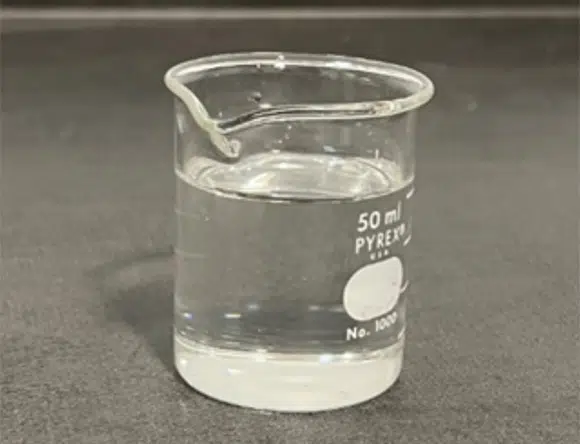
Figure 1. Mineral Oil Sample
This highly refined petroleum product comprises a complex combination of hydrocarbons and alkanes. The chemical composition is variable and set by the manufacturer depending on the desired performance and properties. The colourless and odorless oil has applications in various industries (Table 1). While all mineral oil is refined, white mineral oil used in food and medical applications is purified to remove any ingredients that may damage health.
The thermophysical properties of mineral oil are the characteristics that describe how it behaves under different conditions of temperature, pressure, and flow. Some of these properties include density, thermal conductivity, and viscosity. As mentioned previously, specific properties may vary based on the composition set by the manufacturer. In general, mineral oil is known for having low density, insulative capabilities, and generally having higher viscosity than water.
Table 1. Different applications of mineral oil.
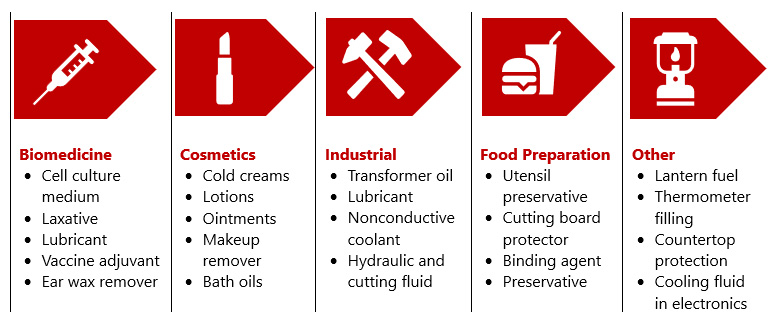
Featured in Table 1 are some of the many applications of mineral oil across various industries, including fabrication, lubrication, pesticides, cosmetics, food processing, and pharmaceuticals. Light mineral oil, deemed safe for consumption, is primarily used as a laxative for humans and animals. It is also commonly used in creams and ointments to hydrate dry skin and can even be a binding agent in food processing.
Less refined mineral oil is widely used for industrial applications with low thermal and electrical conductivity. Being nonconductive is a crucial component of coolants and thermal fluids in electrical systems. Mineral oil is a known lubricant frequently used in precision grinders and hydraulic systems. This complex compound has seemingly endless applications because of its favourable properties.
The MP-V is designed to test the absolute thermal conductivity, thermal diffusivity, specific heat, and thermal effusivity of solids, liquids, pastes and powders. The MP-V features a powerful combination of transient plane source (TPS, ISO 22007-2) and transient hot-wire (THW, ASTM D7896-19) methods with a variety of compatible sensors.
Transient methods share similar theories with differences specific to their primary design. The sensors are electrically connected to a power supply and sensing circuit. A current passes through the sensors and increases temperature, which is recorded over time. The heat generated is then diffused into the sample at a rate dependent on the thermal transport characteristics of the material.
The MP-V features the proprietary intelligent Transient Plane Source (iTPS) function designed for testing and analysis automation. iTPS requires only the sample name as user input, and each sample’s appropriate sensor and test parameters are determined.
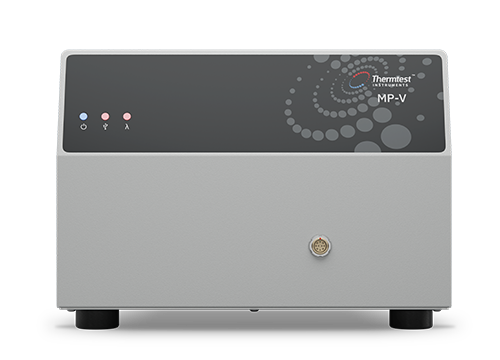
Figure 2. Measurement Platform Versatile (MP-V)
The Transient Hot Wire (THW-L200) sensor is one of the many sensors offered with Thermtests’ Measurement Platform Versatile (MP-V). The THW-L200 sensor provides simple yet accurate measurements of liquids and phase change materials (PCMs) from 0.01 to 2 W/m·K via the transient hot wire method and has a temperature range of -50 to 200°C. This sensor can withstand 20 bar/300 psi of pressure and adheres to an internationally recognized testing standard by complying with ASTM D7896-19. All Thermtest THW sensors have 2% accuracy and 1% reproducibility of measurements, making them a highly accurate and precise instrument for measuring the thermal conductivity of fluids.
The THW sensor has a detect current setting that determines the appropriate amount of current to apply based on a test measurement. By reading the test measurement results, a current will be set that results in an optimal temperature rise of the sample during testing. The sensor can be easily inserted into the sample holder, which has a capacity of up to 20 mL of liquid.
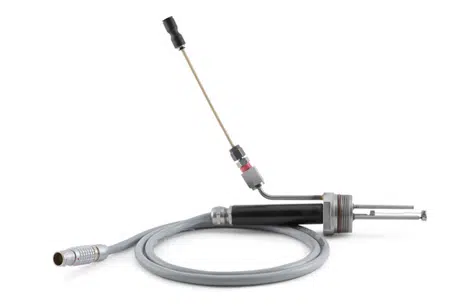
Figure 3. The THW-L200 sensor
For this experiment, the thermal properties of Fisher ChemicalTM Mineral Oil were measured with the Measurement Platform Versatile (MP-V) and the Transient Hot Wire (THW) method. Roughly 20mL of the sample was added to the provided sample holder to be measured. Optimal parameters were determined using the detect current setting to achieve appropriate temperature rise and accurate, repeatable results.
Table 4. Thermophysical measurements of Mineral Oil with THW-L sensor.
| Temperature (°C) | Thermal Conductivity (W/m·K) | Thermal Diffusivity (mm2/s) | Volumetric Specific Heat (MJ/m3K) |
| 0 | 0.136 | 0.080 | 1.700 |
| 10 | 0.134 | 0.078 | 1.705 |
| 20 | 0.132 | 0.076 | 1.731 |
| 30 | 0.130 | 0.072 | 1.801 |
| 40 | 0.129 | 0.074 | 1.746 |
| 50 | 0.126 | 0.070 | 1.814 |
| 60 | 0.127 | 0.074 | 1.721 |
| 70 | 0.124 | 0.072 | 1.738 |
| 80 | 0.122 | 0.073 | 1.671 |
| 90 | 0.122 | 0.079 | 1.546 |
| 100 | 0.119 | 0.075 | 1.593 |
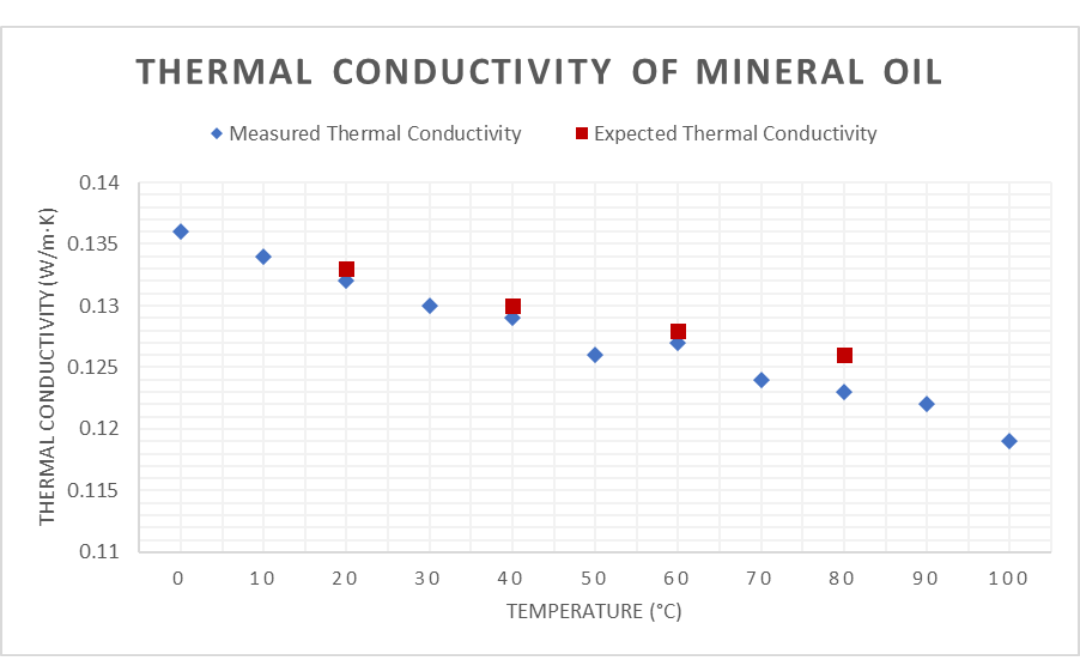
Figure 4. The comparison of measured and expected thermal conductivity (W/m·K) values of mineral oil, measured using the MP-V with the THW-L200 sensor from 0-100°C.
Mineral oil is a widely applicable, highly refined petroleum product. Understanding the thermal conductivity of this pure, natural oil is crucial for its use in many industries. The MP-V THW method accurately and reliably measures the thermal conductivities of liquids and phase change materials. This accuracy is apparent from the minimal disparity between measured values and expected values of mineral oil. The THW-L200 sensor successfully measured the thermal conductivity of mineral oil within 2% of the expected literature values.
Huang, L., & Liu, L.-S. (2009). Simultaneous determination of thermal conductivity and thermal diffusivity of food and agricultural materials using a transient plane-source method. Journal of Food Engineering, 95(1), 179–185. https://doi.org/10.1016/j.jfoodeng.2009.04.024
Mineral oil. ChemicalBook. (2023, September 1). https://www.chemicalbook.com/ChemicalProductProperty_EN_CB4111739.htm
Nadolny, Z., & Dombek, G. (2017). Thermal properties of mixtures of mineral oil and natural ester in terms of their application in the Transformer. E3S Web of Conferences, 19, 01040. https://doi.org/10.1051/e3sconf/20171901040
Shivokevich, P., Olsen, S., & Canary, C. (2021, March). Mineral Oil – Technical Report. Agricultural Marketing Service. https://www.ams.usda.gov/sites/default/files/media/MineralOilTR2021.pdf